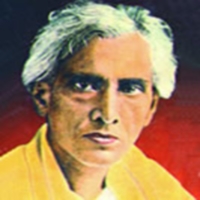Sarat Chandra Chatterjee was born at Devanandapur, Hooghly in 1876 and received his primary school education at Hooghly Branch school but he was bred up in his mother’s family at Bhagalpur where he received his school education and college education for two years. The death of his parents wrecked his home life and for some years he was to lead the life of a wail in North Bihar. In 1903 he went to Burma and found employment in Rangoon as a clerk in the Govt office.
On the eve of his departure to Burma, he submitted a short story for a prize competition in the name of his uncle Surendranath Ganguli. It won the first prize and was published in 1904. A long story (badadidi) was published in two installments in his own name in Bharati (1907). He was the first novelist in India to live in some comfort on the returns of his output. His instantaneous fame and continued popularity are without a parallel in our literary history. Some of his stories are very striking for their obvious sincerity and basic realism. These include Bindur chele (Bindu’s Son, 1913), Ramer Sumati (Ram Returning to Sanity, 1914), Arakshaniya (The Girl Whose Marriage is Overdue, 1916), etc. Saratchandra’s earliest writings show striking influence of Bankim Chandra Chatterjee. In Devdas (written in 1901, published 1917), Parinita (The Married Girl, 1914), Biraj Bau (Mrs. Biraj, 1914) and Palli Samaj (The Village Commune, 1916), the themes and their treatment are not very much different from the older Chatterjee’s but they are presented in a modernistic setting and in an easier and more matter-of-fact language. He is certainly critical of his own ideas but he never flouts the accepted moral basis of the Hindu society of any time.
Chatterjee is at his best when he draws from his experience. To name the more important of such works : Srikanta in four parts (1917,1918,1927,1933), Charitrahin (Character-less, 1917), Biraj Bau (1914), Palli Samaj (1916), the first part of Devdasa (his first novel) and his first published short story Mandir (1904). It may be noted that these (with the exception of the last two part of Srikanta) belong to the first phase of Chatterjee’s literary career, that is up to 1913 when he had been just recognized as a powerful writer of fiction. The second phase began with the conscious attempt to tackle a plot that is akin to Tagore’s Gora. The result was his the biggest novel Grihadaha (Home Burnt, 1919). The spinning out a thin story is rather wearisome and it was never received with the usual acclamation. Before he finished Grihadaha, Chatterjee had reverted to the romantic love story Datta (The Girl Given Away, serialized 1917-19) and Dena-Paona (debts and demands, 1923) were written.
The revolutionary movement from Bengal operating in Burma and in Far East supplied the background of the romance Pather Dabi (The Demand of the Road, 1926). The novel for no cogent reason was proscribed by the Government. In Bipradas (1935) Chatterjee returns to the domestic novel but it scarcely reveals a new approach or a fresh appraisal. His last complete novel Sesh Prasna (The Final Question, 1931) is an attempt at the ‘intellectual’ novel where the meager theme is inflated by high brow talks on problems of the individual and of the society relating principally to love and marriage.
Some of the popular tales of Chatterjee were dramatized and performed on the public stage with considerable success. Chatterjee’s works have been repeatedly translated into all the major Indian languages


No comments yet.